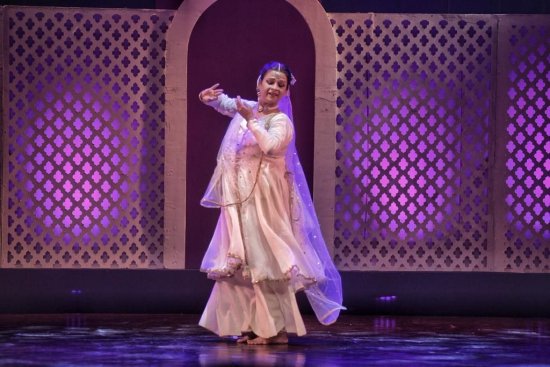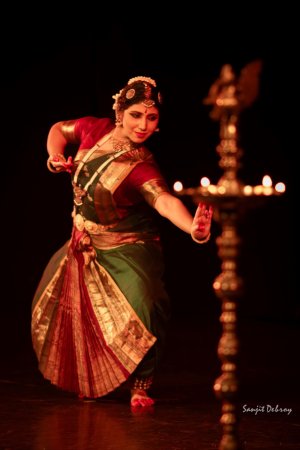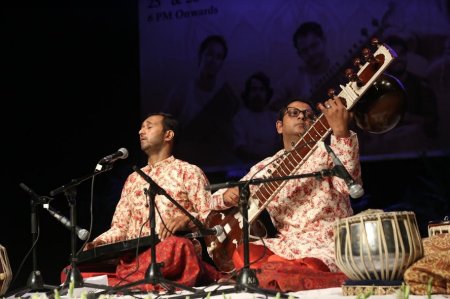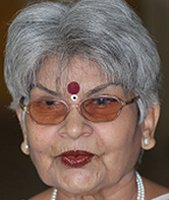
|   |

|   |
Ruhaniyat, Saukariyam and Guru M. L. Koser Festival - Manjari Sinha e-mail: manjari@sinha.com December 14, 2023 'Ecstasy' was the keyword in the music and dance concert scene of the capital this past fortnight. Aamad Kathak Dance Centre of Rani Khanam presented 'Ruhaniyat: a Journey of Spiritual Ecstasy with Sufi Kalaam and Raqs', Angamantra Kolkata in association with the Habitat Centre, Delhi showcased 'Saukariyam - The Aesthetic' at the Stein auditorium and the Pracheen Kala Kendra Chandigarh presented its 11th Guru M. L. Koser Festival, a two-day offering of music and dance as a tribute to the late Guru at Kamani auditorium, Delhi. Groomed under the doyen of Kathak Pt. Birju Maharaj, Rani Khanam symbolises the delicate grace and sophistication of Lucknow Gharana. Her own bent of mind towards 'Sufism' has led her delve deep, research and study Sufi poetry at great length. She has been offering meaningful productions based on Sufi thoughts in the language of Kathak. This year she came forth with 'Ruhaniyat.' The enchanting evening featured Sufi poetry of Bulle Shah, Azan Fakir, Nawab Sadiq Jung Bahadur, and Hamid Kolkata Wale.  Rani Khanam Ably accompanied on tabla by Aman Ali, vocals by Shuheb Hasan and Zoheb Hasan, sitar by Fateh Ali, dholak by Sanjeev Kumar and padhant by Nisha Kesari, she opened with "Zara kholo kevadiya Maharaja Moinuddin", a poem portraying the shringar bhakti, penned by the eminent poet Hamid Kolkata Wale. It beautifully illustrated the deep connection between the Peer (guru) and the Murshid (disciple) in discovering the path to reach the Almighty. Based on the sonorous swaras of raga Bageshri, this piece elaborated the lyrics exploring divine love, through bol-aalap in the Qawwali format with dholak and the typical clap of Qawwali joining the melodious orchestra. The second rendition "Kanhaiya yaad hai kuchh bhi humaari" written by Nawab Sadiq Jung Bahadur of Hyderabad, was a bhakti-soaked verse for Krishna from the perspective of a Sakhi (a female friend) who is immersed in his love and seeks to know if he also remembers her. Set to the Deepchandi Theka the song converts to rupak taal of seven beats to incorporate the nritta segments in-between the stanzas. It was also interspersed with couplets like "Tanik kaankari ke pare nain hot bechain / Un nainan mein chain kahaan, jin nainan mein nain!" and Kavitta of Misra Jati Chhand. The third was a Zikir in Assamese dialect, "Mor monot bhed bhav nahi Allah," negating any kind of discrimination amongst living beings, humans, insects, birds, animals or any kind of caste and creed, widely popularized in Assam by the Sufi saint Azan Fakir, who had come from Baghdad and became a Murshid of Shrimanta Sankaradeva. Rani had imaginatively used the folk tune of Assam and the 'Naav ki Gat' for entry and exit symbolic of the Brahmaputra. The concluding performance of "Hori khelungi kah kar bismillah" by Baba Bulleh Shah, climaxing with the 'Rang' speeding into a crescendo created a parallel between the vibrant colors of the festival and the divine consciousness, or taqwa, that resides within us. Rani talked about the 'Ganga-Jamuni tahzeed' and explained, "Playing Holi with spiritual intention can lead us to experience transformation, as the colors symbolize the infusion of divine love. It's a cultural journey that goes beyond limitations to reunite us with our spiritual selves bringing forth the divine in every person." Ruhaniyat was really a celebration of the divine through the rich tapestry of Sufi poetry and dance. SAUKARIYAM - THE AESTHETIC Angamantra, the Bharatanatyam institute of Samrat Dutta, Kolkata, in association with the Habitat Centre, Delhi, presented 'Saukariyam', the aesthetics of dance through solo and duet Bharatanatyam and Marga Natya presentations featuring Samrat Dutta, Santanu Roy, Tanya Saxena, Akash Mallick and Pinki Mondal. An eminent Bharatanatyam dancer, choreographer and teacher, Samrat Dutta is a senior disciple of Prof C.V Chandrasekhar. Also trained in Marga Natya under Guru Kalamandalam Piyal Bhattachacrya, Samrat Dutta is the founder director of Angamantra, established in 2005. Samrat has been creating researched choreographic works, assimilating both the traditional and experimental aspects of the art form.  Santanu Roy & Samrat Dutta Photo: Kkrishnan Photography Saukariyam, underlining the aesthetics of dance, opened with 'Dasha Mahavidya', a researched dance work of Angamantra, presented as a duet by Samrat Dutta and his well-groomed disciple Santanu Roy depicting the ten forms of Parashakti as referred in Tantra philosophy. The Dasha Mahavidya are the sacred Devis, namely Kamala, Kali, Tara, Bagalamukhi, Bhairavi, Bhuvaneshwari, Dhumavati, Matangi, Chinnamasta and Shodashi which are revered as the Dashavataras. Composed in Dash Ragamalika, a garland of ten ragas like Kalawati, Kalyani (Yaman), Vibhas, Shivaranjani etc and set to Talamalika of varied talas, the impressive production was not just an invocation of the Dasha Mahavidya through their dhyana mantras, but also had deep reflection of intense human emotions, the Nava Rasas and the stages through which human beings gradually evolve towards completeness. The stage presence of the two dancers, chiselled technique and their capacity of deep involvement with the content, were the hallmarks of their impeccable presentation.  Tanya Saxena Photo: Sanjit Debroy The second presentation of Saukariyam was a sumptuous solo performance by the vivacious Bharatanatyam dancer Tanya Saxena, who is also known for her interdisciplinary work. Tanya presented the famous Khamas Varnam of the Tanjore Quartet where the Nayika asks her Sakhi, "Go and fetch my Lord Sundareshwara who stands in Madurai in the Nataraja posture." She tells the Sakhi all about her love for the Lord and how she is pining to meet him. Tanya impressed with her command on both the nritta and abhinaya aspects of this challenging piece that juxtaposed complex rhythmic jatis with intense abhinaya.  Akash Mallick and Pinki Mondal The last presentation was Marga Natya by Akash Mallick and Pinki Mondal. Rooted in the prescribed practices of nritta, geet and abhinaya as outlined in Bharata's Natya Shastra, Marga Natya strives to maintain a delicate balance between tradition and creative expression, as envisioned and researched by Piyal Bhattacharya. Opening with Asarita Vardhamana Vidhi as a duet by Akash and Pinki, the next was a solo by Akash, performing Panik Vidhi which had four segments Mukha, Pratimukh, Sharira and Samharana composed in Choksho Shadava Gram raga. Two of the Sapta Kapaala Geetis were also presented. First the Shadji Kapaal Geeti and then the Naishadi Kapaala Geeti performed as the concluding duet by Akash Mallick and Pinki Mondal. Marga Natya was new to many in the audience but the graceful dance form and the artistic presentation heralded loud applause. THE 11TH GURU M. L. KOSER FESTIVAL OF MUSIC & DANCE The Pracheen Kala Kendra (PKK) was established in Chandigarh by the late Guru M. L. Koser way back in 1956 with the mission to preserve and propagate Indian classical arts. The premier educational organization has proliferated with many branches in India and abroad, disseminating Indian classical music, dance and fine arts by imparting education. At present it has a network of 3800 affiliated centres.  Debapriya Adhikari and Samanvaya Sarkar Guru M. L. Koser Festival is their annual tribute to PKK's founder president. The 11th Guru M.L. Koser Festival of Music and Dance was held this year as a two-day festival at the capital's Kamani auditorium. Opening with a Hindustani vocal and sitar jugalbandi by the gifted duo Debapriya Adhikari and Samanvaya Sarkar, the inaugural evening concluded with the enchanting Odissi dance featuring Sujata Mohapatra and her dance ensemble. Debapriya Adhikari is trained under Pt. Samaresh Chaudhury of Kirana Gharana, Pt. Kumar Prasad Mukherji and Pt. Vijay Kichlu of Agra Atrauli Gharana and presently being groomed in Dhrupad ang gayaki under Pt. Uday Bhawalkar. Initiated by his father, Samanvaya was groomed under Pt. Manilal Naag. They both are also ganda-bandh shishyas of Girija Devi. Opening with a detailed Dhrupad ang aalap in raga Maru, they presented a madhya laya (medium tempo) Khayal in jhaptal, a Chhota Khayal in teentala and a tarana accompanied on tabla by Ranjan Barthakur and Debjit Patitundi. This was followed with an unusual Tappa in Purvi raga and a Dadra in Mishra Charukeshi. The duo concluded with a soulful bhajan.  Sujata Mohapatra & group The inaugural evening reached its climax with the captivating Odissi dance performance by Sujata Mohapatra with a melodious live orchestra comprising Rajesh Kumar Lenka - vocal, Ekalavya Muduli - pakhawaj, Ramesh Chandra Das - violin, Rudra Prasad Swain - flute and Samir Kumar - manjeera. Opening with the Mangalacharan invoking Jagannatha in raga Gurjari Todi set to triputa tala, a group choreography by Guru Ratikant Mohapatra, Sujata presented Hamsadhwani Pallavi in Ektali. Starting with slow, delicate movements it built a fast paced crescendo. The abhinaya piece was the popular Odia song "Kede Chanda.." in raga Mishra Kafi set to rupak tala. The well synchronized group concluded their mesmerising performance with Dashavatara from Jayadeva's Geeta Govinda. The second evening featured a Hindustani vocal recital by Indrani Mukherjee followed by solo and duet on violin by classical fusion artist Deepak Pandit and the renowned Jazz drummer Ranjit Barot.  Manjari Sinha has an M.A. in Sanskrit and Music, and Sangeet Prabhakar in vocal, tabla, sitar and Kathak dance. She has regular columns in national dailies as a music and dance critic. |